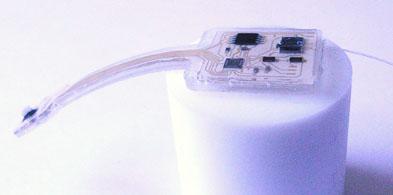PROVIDENCE, R.I. [Brown University] — State-of-the-art brain implants that record or stimulate neural activity to help people with nervous system damage will be made possible under a major new National Institutes of Health grant awarded to Brown University, Cyberkinetics Neurotechnology Systems Inc. and the Cleveland Functional Electrical Stimulation (FES) Center at Case Western Reserve University.
The National Institute of Biomedical Imaging and Bioengineering and the National Institute of Child Health and Human Development awarded the five-year, $6.5-million grant to Brown, which will coordinate research with partners from Cyberkinetics and the Cleveland FES Center.
The innovative university-industry team will develop a “microsystem-on-a-chip” – a neural interface that is thin, flexible and about as big as an adhesive bandage. Unlike any other neural interface, the new system will be fully implantable and will communicate wirelessly. Information from the brain will be transmitted through the skin in a digital data streaming technique similar to high-speed optical telecommunications. That digitized data can be used to control assistive devices, such as computers or wheelchairs, which bring independence to people with paralysis.
“This grant will take neural interfaces to the next level,” said John Donoghue, a Brown neuroscientist and the chief scientific officer at Cyberkinetics. “The devices that come out of this project will bring us much closer to our goal of helping people who can’t move or who struggle to communicate because of central nervous system injuries or disorders.”
Arto Nurmikko, a Brown professor of engineering and physics, will lead the team developing the new silicon-encapsulated system, which will consist of a sensor and signal processor at one end and a high-speed signal transmitter and power source at the other. In one version, the system will send a stream of digital data down a hair-thin fiber optic cable under the skin that leads to a pacemaker-sized power and processing unit in the chest. This unit will provide a strong, stable optical signal that can be used as a command source to control wheelchairs, prosthetic limbs, or other devices.
This new technology will also provide a wireless sensor for BrainGate, the system that turns the brain’s electrical signals into movement commands. BrainGate has allowed people with paralysis to operate a computer in order to read e-mail, control a wheelchair and operate a robotic hand in FDA-approved pilot trials overseen by Cyberkinetics. Brown faculty and students created the Foxborough, Mass., company based on research and technology developed in the Donoghue laboratory.
Right now, BrainGate involves a sensor implanted in the brain, a connector that protrudes through the scalp and a cable that extends from the connector, carrying the brain’s signals out of the body to a set of paperback-sized computer processors that translate those signals into movement commands. The new system will be much smaller and sit under the skin.
“We are extremely pleased to receive this – our second major award – from the NIH to fund development of BrainGate technology,” said Timothy R. Surgenor, Cyberkinetics’ president and CEO. “This award underscores the leadership position that Cyberkinetics, Brown and Case Western Reserve have attained in moving this groundbreaking science toward a product that may someday provide practical benefits and independence for paralyzed people.”
The new technology could have applications beyond the control of assistive devices. Brain signals recorded and decoded by the device could be used to detect and predict epileptic seizures. Or the system might be used to treat disorders ranging from depression to Parkinson’s disease.
The research funding will allow the scientists to test the new wireless system – already a prototype in the Nurmikko lab – in a human patient with paralysis of all four limbs.
The grant will also allow scientists to develop a similar microsystem that stimulates, rather than records, brain activity. This technology would eventually allow for feedback that restores touch perception to people with paralysis or other nervous system damage. This ability to feel heat, pressure and pain is important for normal interaction with the world.
The group is also planning to couple its wireless neural interface to a functional electrical stimulation (FES) system, which uses electrical impulses to trigger muscle and limb movement. Such a system would recreate the normal path from brain to muscles using physical components, allowing people with paralysis to make simple movements under direct brain control that could potentially be used to perform tasks such as eating or drinking.
P. Hunter Peckham, professor of biomedical engineering and orthopaedics at Case Western Reserve and executive director of the Cleveland FES Center, is a world leader in creating and testing FES systems, which can produce and control the movement of otherwise paralyzed limbs, stop pain or muscle spasms, and activate bodily functions such as bladder control.
“This grant provides the opportunity to interface the proposed brain stimulation and recording system with our networked neuroprosthesis, or NNP, system being developed through a separate project,” Peckham said. “The NNP system is our next-generation neuroprosthesis platform that will be used for a wide variety of applications and represents the logical way to move cortical control of various body functions into human applications as quickly as possible.”
The NIH grant will continue the innovative research collaboration between Brown and Cyberkinetics, as well as the strong scientific partnership between Brown and Case Western Reserve, both leaders in neuroprosthetics. This fast-growing field brings together engineers, biologists, and computer scientists to create devices to repair the nervous system.

